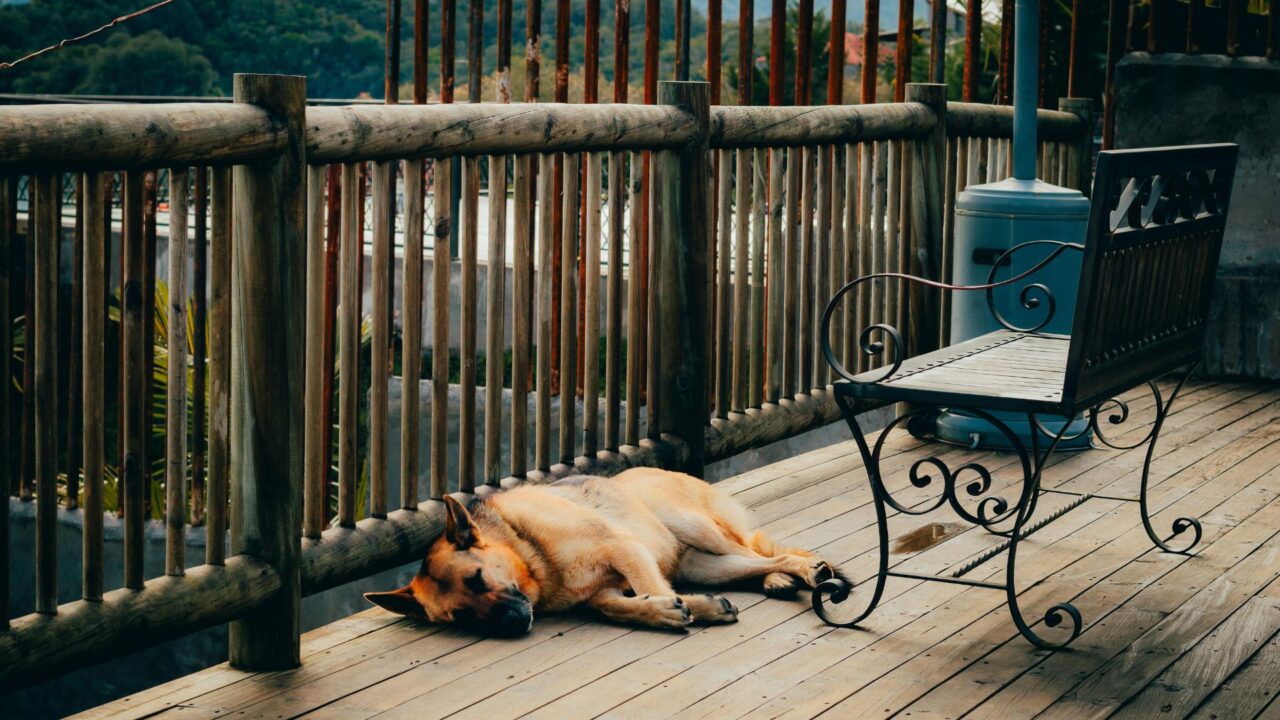Pressure-treated wood is not safe for pets to chew or ingest. It contains chemical preservatives designed to resist rot and insects, but those same compounds can cause vomiting, diarrhea, lethargy, or worse if eaten. For dog houses, rabbit hutches, or chicken coops, choose untreated or naturally rot-resistant woods like cedar or pine instead. If your pet chews treated lumber, contact a veterinarian immediately.
What Makes Pressure-Treated Wood Unsafe
Pressure-treated lumber is infused with chemical preservatives under pressure to resist rot and insects.
Common types include:
-
ACQ (Alkaline Copper Quaternary)
-
CA (Copper Azole)
-
MCA (Micronized Copper Azole)
While far safer than older arsenic-based formulas (CCA, phased out in 2003), they still contain copper compounds and biocides that are toxic when ingested.
Animals are most at risk when they chew, gnaw, or peck on boards.
-
Dogs may chew deck edges or fences.
-
Rabbits and rodents constantly gnaw.
-
Chickens and ducks peck at roosts and framing.
-
Cats may scratch or rest on contaminated surfaces.
Walking across treated decks isn’t dangerous, but chewing, licking, or contact with soil and runoff near treated lumber raises the risk.
What Happens When a Pet Eats Pressure-Treated Wood
When pets chew treated wood, they ingest both splinters and chemical residues.
Toxic reactions vary by animal size and dose, but copper poisoning is the most common concern.
Typical symptoms include:
-
Excessive drooling or pawing at the mouth
-
Vomiting or diarrhea
-
Weakness, loss of appetite, or fatigue
-
Swollen mouth or tongue
-
Tremors or unsteady movement (in severe cases)
What to do:
-
Rinse the mouth with clean water if safe to do so.
-
Do not induce vomiting unless instructed by a vet.
-
Call your veterinarian or an emergency animal hospital right away.
Bring details: how much was eaten, type of wood, or even a small piece for identification.
Prompt care often prevents lasting damage.
Hidden Risks: Runoff, Dust, and Soil Contact
Even if pets don’t chew the wood directly, indirect exposure can happen through:
-
Rain runoff carrying copper into soil, puddles, or garden beds
-
Sawdust from cutting or sanding treated lumber (especially harmful if inhaled or licked)
-
Old CCA decks or fence posts that still contain arsenic
For Cleveland-area homeowners, this risk increases during rainy springs and freeze–thaw winters, when snowmelt can leach chemicals into play areas or gardens where animals roam.
Avoid burning treated wood scraps. The smoke and ash contain toxic residues that are hazardous to both pets and people.
Safer Ways to Build Outdoor Pet Structures
When building or repairing a dog house, hutch, coop, or run, material choice matters just as much as design.
Avoid Pressure-Treated Wood For:
-
Interior walls or floors of dog houses
-
Roosts, perches, or nesting boxes for chickens
-
Rabbit hutches and small animal pens
-
Any surface pets chew, scratch, or rest on
Limited Safe Use
Pressure-treated lumber can be used where animals cannot reach it directly, such as:
-
Buried fence posts
-
Structural beams under raised decks
-
Framing beneath a chicken run’s wire base
When used this way, add a barrier (metal flashing, untreated wood facing, or sealed plywood) to prevent contact.
Safer Alternatives for Pet Structures
| Material | Benefits | Drawbacks | Notes |
|---|---|---|---|
| Cedar | Naturally rot-resistant, pleasant scent, long lifespan | More expensive | Great for dog houses, coops, and hutches |
| Redwood | Highly durable, resists decay | Costly, less available | Ideal for premium builds |
| Untreated Pine | Affordable, easy to find | Needs sealing every 1–2 years | Safe if sealed with non-toxic outdoor sealer |
| Thermally Modified Wood | Heat-treated, chemical-free | Higher price | Excellent for high-moisture outdoor areas |
| Composite Boards | Long-lasting, no chemical leaching | Can be slippery or hot for paws | Good for decks and fence rails, not chew zones |
Seal untreated woods with a water-based, pet-safe exterior finish to extend lifespan while avoiding harmful additives.
Species-Specific Guidance
Dogs
Dogs explore by chewing. Avoid treated lumber in kennels, fences, or decks within reach. Use cedar or sealed pine for durability and scent resistance.
Cats
Less likely to chew, but may scratch or lounge on contaminated boards. Use untreated materials for shelters and outdoor furniture.
Rabbits & Guinea Pigs
Constant gnawers — pressure-treated hutches or pens are unsafe, even if painted or sealed. Use untreated pine, birch plywood, or hardwood.
Chickens & Ducks
Often peck at wood and soil. Keep treated lumber limited to buried posts. Use untreated wood for roosts, perches, and interior framing.
Backyard Ponds or Runs
Avoid using treated lumber near fish ponds or duck pools — runoff can cause aquatic toxicity.
If You Already Used Pressure-Treated Wood
Many pet owners only learn about the risks after construction. If that’s you, you can still reduce exposure:
-
Seal surfaces with a pet-safe exterior sealer to limit leaching.
-
Cover chewable edges with untreated trim or metal flashing.
-
Replace interior parts (roosts, flooring, walls) with untreated wood.
-
Keep food and water bowls off treated surfaces and away from deck edges.
-
Monitor soil moisture near treated posts; add gravel or pavers to reduce runoff contact.
When to Call a Veterinarian
Seek veterinary care immediately if you suspect ingestion.
Bring:
-
A piece of the wood or packaging label if possible
-
Time since exposure
-
Approximate amount ingested
Tests may include:
-
Blood copper or liver enzyme levels
-
Abdominal X-rays if wood fragments were swallowed
-
Supportive care such as IV fluids or anti-nausea medication
Early treatment typically prevents serious complications.
FAQs About Pressure-Treated Wood and Pets
Is pressure-treated wood safe for dog houses?
No. Dogs often chew wood, and ingestion can cause illness. Use cedar or sealed untreated pine instead.
Can chickens roost on treated wood?
Avoid it. Chickens spend long hours roosting, and constant contact increases exposure risk.
Is treated lumber okay for fence posts or buried supports?
Yes — as long as pets can’t chew or lick it. Limit use to below-ground structural elements.
Can I make treated wood safe by sealing it?
Sealing helps reduce contact but doesn’t make it safe to chew. Over time, the coating wears off, so untreated lumber is still best.
What should I do if my rabbit or dog chews treated wood?
Rinse the mouth, remove access to the wood, and call your vet immediately. Even small amounts can be harmful for small animals.

